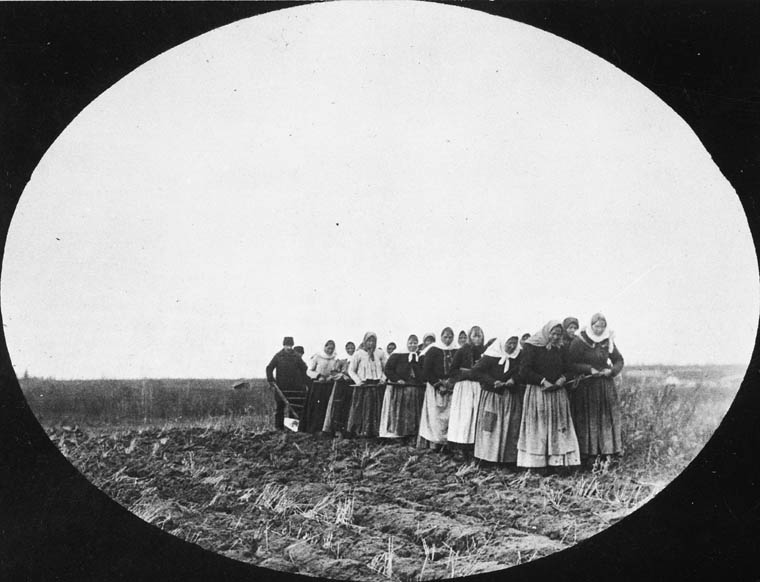15 Baba Wore a Burqa, and Nona Wore a Niqab
Franca Iacovetta and Karen Dubinsky
Last week, two high-profile Canadian Muslim women, writer Sheema Khan and Zunera Ishaq (the woman at the centre of the niqab controversy), publicly questioned the safety of Muslims in this country. Khan lived here in the aftermath of 9/11; she says it’s worse now in 2015.1 These admissions amount to a tragic statement about the use of the niqab as an election issue. Yet as Canadian women’s historians, we have heard it before. Intolerant Canadians, from political elites to ordinary citizens, have long attempted to impose their notions of what it means to be a Canadian on the bodies of immigrant women. Today’s veiled Muslim woman joins a long line of immigrant women whom this country has feared or pitied, but always stereotyped, for at least a century.
Consider those Doukhobor women harnessed to a plough, breaking the tough Prairie. Their photos, faces almost hidden by their babushkas, have graced Canadian history textbooks for decades. The widely shared image–reproduced as a postcard inviting everyone to get a look–struck many Canadians as the personification of a backward European peasant culture that treated its women like downtrodden beasts of burden. These women posed a striking contrast to the prevailing middle-class ideal of the Victorian woman, that morally superior angel in the home. Consider too the distinctive dress of the women who completed the portrait of Immigration Minister Clifford Sifton’s ideal Eastern European peasant “in a sheepskin coat” with “a stout wife and a half-dozen children” grudgingly welcomed to Canada. Someone needed to do the backbreaking labour to settle what was portrayed as an empty Prairie, the original First Nations inhabitants having been relegated to reserves. Even Icelandic pioneer women, easily assimilated, one might expect, into the Nordic race, were castigated for their typical headdress: a dark knitted skullcap with tassel. Such women may now be considered Old Stock Canadians, but not so long ago, their Anglo neighbours viewed them as second-class. According to historian Sarah Carter, Anglo women’s organization in Alberta thought Ukrainian girls so deficient in the standards of proper womanhood that they too should be sent to residential schools.

Then, too, there are the Jewish, Italian, Polish, Hungarian and other women who settled in Canada’s cities. Crowded into slum housing, these women were reduced to static folk-figures who enacted strange religious rituals and stunk up their neighbourhood with fermenting cabbage. Social workers investigated these “underworlds” and ridiculed the mamas who pushed and shoved and haggled at markets in a most unwomanly manner. Italian women, viewed by reformers as unschooled, oppressed, and shadowed by black kerchiefs, were deemed the least likely of all to adjust to Canadian life.
What is it about the women-folk that make people so anxious? Women rarely run countries but they certainly symbolize the nation. Immigrant women preserve the culture of the group. They cook the food and raise the children and pass on the language. Often they dress distinctively. They stand out.
Born of fear, stereotypes obscure more than they reveal. The Baba on the homestead ploughed while the men worked on the railroads or in the mines. Italian women entered the labour force in large numbers, their paycheques compensating their husbands’ seasonal unemployment. Today’s headscarfed refugee woman might be a teacher, a nurse, or a community organizer.
Of course immigrant men have not always been warmly welcomed in this country. Canadian immigration history is full of examples of discrimination: the Chinese Head Tax, Sikh men forbidden to disembark in Vancouver’s harbour, Black men refused entry by a variety of barriers. The demonization of Muslims also has long roots and it has taken its own course in Canada.
Yet generations of immigrant women have experienced a particular form of racism: a mix of charity and contempt. Very Canadian. In the niqab controversy we see cynical electioneering but also the remnants of some old anxieties about the nonas, babas and omas of previous generations. Just as there have always been scapegoats, susceptible to the political manipulations of the day, there has also been an audience, willing to believe the worst.
Now a Canadian citizen, Zunera Ishaq has refused to let Prime Minister Stephen Harper speak on her behalf. This also illustrates another familiar historical pattern: immigrant women have rarely been silent in the face of discrimination.

